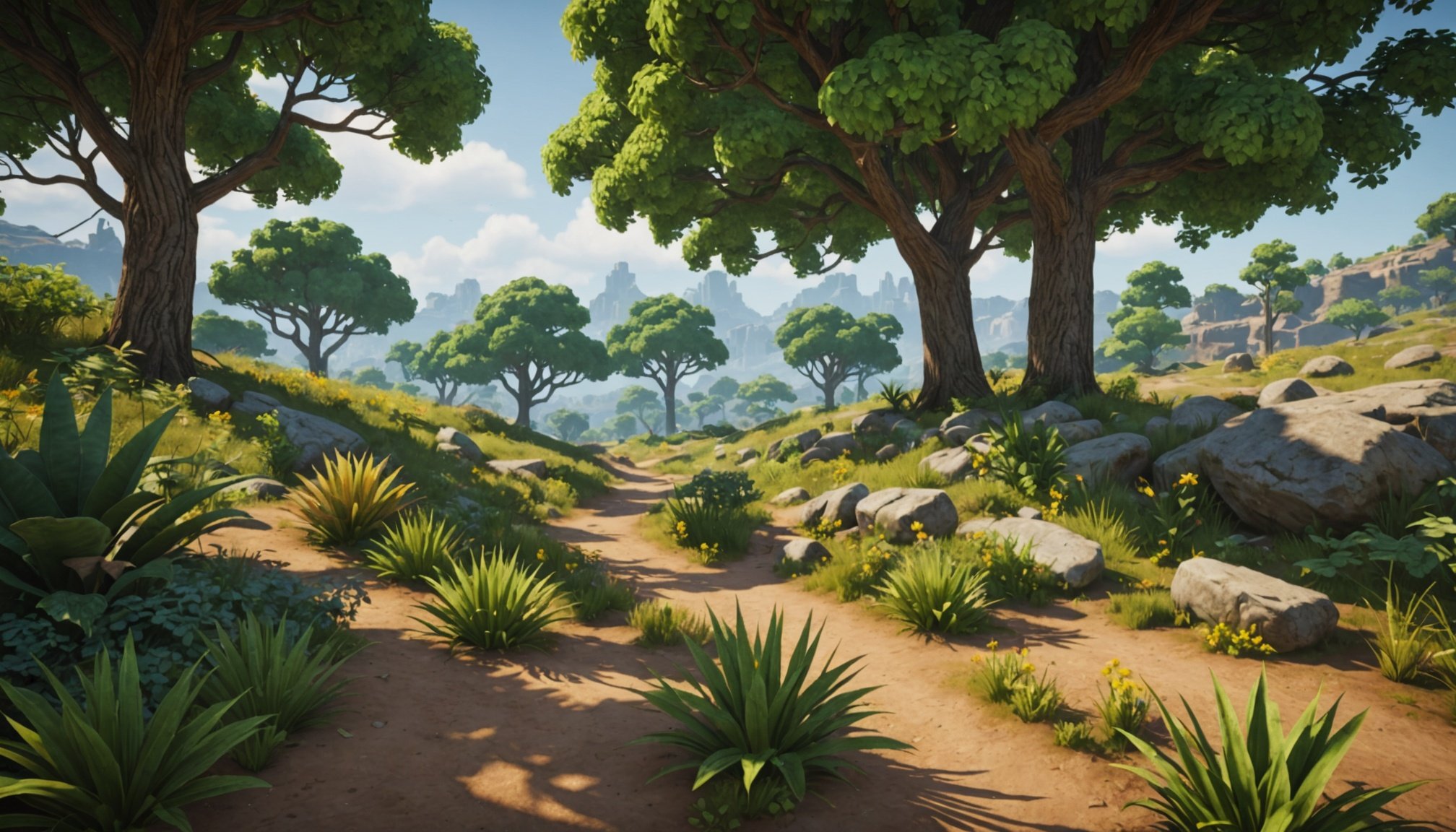Creating immersive worlds hinges on the authenticity of their environments. Achieving realistic flora can significantly enhance the player's experience in open-world adventure games. Developers face the challenge of balancing aesthetics, performance, and gameplay dynamics. This guide provides actionable strategies for incorporating diverse vegetation, leveraging procedural generation, and utilizing advanced texturing techniques. By focusing on these elements, developers can craft lush, vibrant landscapes that captivate players and enrich storytelling.
Advanced Techniques for Realistic Flora Design
Exploring the art of virtual vegetation
In the same genre : Mastering AI: Strategies for Developers to Enhance Realistic NPC Responses in Horror Gaming
Techniques and Importance
Creating realistic vegetation techniques in game design is crucial for enhancing the gameplay experience. These techniques involve using sophisticated algorithms and detailed textures to mimic the intricacies of real plant life design. By achieving realism, players can become more immersed in the virtual world, feeling as though they are exploring a living, breathing environment.
Case Studies
Several games have successfully integrated realistic flora, setting benchmarks in the industry. For instance:
Also read : What are the challenges of implementing voice-controlled interfaces in strategy games?
- The Witcher 3: Utilizes dynamic weather systems and detailed plant models to create lifelike forests.
- Horizon Zero Dawn: Features diverse ecosystems with meticulously designed plant species that react to the player's presence.
- Red Dead Redemption 2: Offers an expansive world where vegetation changes with the seasons, enhancing realism.
Precision and Recall in Design
Incorporating realistic vegetation requires precision and recall. Designers must balance the number of shared elements between actual and virtual flora (tp) with those that are unique (fp and fn). This balance ensures that the realistic vegetation techniques employed are both accurate and believable, enhancing the overall gameplay experience.
3D Modeling for Vegetation
Harnessing technology for lifelike environments
Best Practices for 3D Modeling Plants
Creating high-quality 3D models of plants involves several best practices. Start with detailed references to capture the unique features of each plant species. Focus on vegetation assets that are versatile and reusable, allowing for diverse applications across different projects.
Tools and Software Recommendations
Selecting the right tools is crucial for efficient 3D modeling. Popular software includes Blender, Maya, and 3ds Max, each offering robust features for designing intricate vegetation assets. These tools provide a range of functions, from sculpting to texturing, that cater to both beginners and seasoned professionals.
Tips for Optimizing 3D Models
Optimizing 3D models of plants is essential for maintaining performance without sacrificing detail. Consider using Level of Detail (LOD) techniques to adjust vegetation assets based on the viewer's proximity. This approach minimizes rendering load while preserving visual fidelity.
- Simplify complex geometries
- Reduce polygon count where possible
- Utilize texture atlases for efficient memory usage
By following these strategies, designers can create compelling, realistic environments that elevate the gaming experience. Emphasizing precision in 3D modeling plants ensures that virtual worlds remain immersive and believable, engaging players at every turn.
Texturing and Material Creation
Enhancing realism through advanced techniques
Techniques for Creating Realistic Textures for Foliage
Creating realistic textures for plants is essential for immersive game environments. Utilizing Physically Based Rendering (PBR) is pivotal in achieving lifelike results. PBR techniques consider how light interacts with surfaces, ensuring materials look consistent under various lighting conditions. This approach is crucial for vegetation materials, providing them with a natural appearance.
Texture maps are indispensable in this process. They define the surface properties of vegetation materials. Common texture maps include:
- Diffuse Maps: Capture the base color of the foliage.
- Normal Maps: Add depth and detail without increasing polygon count.
- Specular Maps: Control the shininess and reflectivity of the surface.
Importance of PBR in Material Design
PBR has revolutionized material design by offering a more accurate representation of how surfaces interact with light. This is particularly important for texturing plants, as it ensures that vegetation materials are visually coherent across different environments. By employing PBR, designers can create textures that respond realistically to dynamic lighting, enhancing the overall aesthetic of the game world.
Incorporating these advanced techniques in texturing plants not only elevates visual fidelity but also contributes to a more engaging and believable player experience.
Environmental Storytelling through Flora
Exploring the narrative power of nature in games
Role of Vegetation in Narrative and Immersion
In the realm of environmental storytelling, flora serves as a powerful tool to enhance both narrative depth and player immersion. Through meticulously designed vegetation, developers can convey a game’s thematic elements and enrich the storyline without explicit dialogue. Flora in games acts as a silent narrator, guiding players through the world while subtly revealing its history and culture.
Strategies for Using Flora to Convey Themes
To effectively use flora in storytelling, developers can employ various strategies. Consider integrating plants that reflect the game’s emotional tone or setting. For instance, barren landscapes with sparse vegetation might symbolize desolation or decay, while lush, vibrant forests could indicate prosperity or mystery.
- Symbolic Flora: Use specific plant species to symbolize themes.
- Dynamic Growth: Allow plants to change over time, reflecting narrative progression.
- Interactive Elements: Enable players to interact with vegetation for storytelling clues.
Analysis of Games Utilizing Plants for Storytelling
Certain games stand out in their use of flora for storytelling. Titles like "The Last of Us" use overgrown cities to depict nature’s reclaiming of human spaces, while "Journey" employs desert flora to symbolize both isolation and beauty. These examples highlight how flora in games can profoundly impact environmental storytelling.
Performance Optimization for Vegetation
Enhancing game efficiency through strategic optimization
Common Performance Pitfalls
In the realm of vegetation performance optimization, certain pitfalls can significantly impact game performance. Overly complex plant models and excessive detail can lead to increased rendering times, affecting frame rates. High polygon counts in vegetation rendering can strain resources, leading to lag and reduced gameplay quality. Additionally, poor texture management can result in excessive memory usage, further degrading performance.
Techniques for Optimizing Vegetation
To achieve effective vegetation performance optimization without sacrificing quality, developers can employ several techniques. Implementing Level of Detail (LOD) ensures that only necessary details are rendered based on the player's distance. Using simplified geometries for distant objects reduces processing demands. Texture atlases can consolidate multiple textures, minimizing memory usage.
- Simplify Geometries: Reduce polygon counts for distant plants.
- Use LOD: Adjust detail levels based on viewer proximity.
- Texture Atlases: Combine textures to optimize memory usage.
Tools for Profiling and Improving Game Performance
Various tools are available to aid in vegetation performance optimization. Profiling tools like NVIDIA Nsight and AMD Radeon GPU Profiler help identify bottlenecks in vegetation rendering. These tools provide insights into rendering times and resource usage, allowing developers to make informed adjustments to enhance game performance.
Integrating Flora with Game Physics
Exploring the synergy between nature and mechanics
Overview of Physics Systems for Dynamic Vegetation
Incorporating flora physics integration into game design requires understanding various physics systems. These systems simulate how dynamic vegetation interacts with environmental elements, enhancing realism. By leveraging physics engines, developers can create lifelike movements and responses in plants, such as swaying in the wind or bending under a character's weight. This attention to detail enriches the player's immersive experience.
Implementing Realistic Interactions
Realistic flora physics integration involves implementing interactions that are both believable and engaging. For instance, as players move through a virtual forest, dynamic vegetation should react naturally, with leaves rustling and branches snapping. This requires precise calculations to ensure interactions are seamless and consistent across different scenarios.
- Wind Effects: Simulate plant movement in response to wind.
- Collision Detection: Ensure plants respond to player and object contact.
- Growth Dynamics: Allow plants to grow or wilt based on game conditions.
Case Studies of Games Using Physics
Several games have mastered flora physics integration to enhance realism. In "The Legend of Zelda: Breath of the Wild," dynamic vegetation reacts to weather changes and player actions, creating a vibrant world. Similarly, "Far Cry 5" uses physics to simulate plant interactions, contributing to its realistic environment. These examples highlight the importance of integrating physics for believable flora.
Tools and Resources for Developers
Essential assets for creating realistic environments
Recommended Software and Tools for Vegetation Design
When embarking on vegetation design for game development, selecting the right game development tools is crucial. Industry favorites include Unreal Engine and Unity, both offering comprehensive features for creating lifelike environments. For more specialized tasks, SpeedTree excels in generating detailed plant models, while Quixel Megascans provides high-resolution textures to enhance realism.
Online Resources and Communities for Developers
The journey of mastering vegetation resources is supported by a wealth of online communities and platforms. Websites like Polycount and forums such as CGSociety offer spaces for developers to share insights, troubleshoot issues, and showcase their work. These platforms are invaluable for networking and learning from industry peers.
Tutorials and Documentation for Further Learning
To deepen your understanding of game development tools and vegetation resources, a variety of tutorials and documentation are available. Consider exploring:
- Official Documentation: Comprehensive guides from software developers.
- YouTube Channels: Visual tutorials for hands-on learning.
- Online Courses: Structured lessons from platforms like Udemy.
These resources empower developers to refine their skills and stay updated with the latest advancements in vegetation design. By leveraging these tools and communities, developers can enhance their projects with realistic and immersive environments.
Future Trends in Vegetation Design
Exploring the next frontier in digital flora
Emerging Technologies and Their Impact
The future of flora design is being reshaped by emerging technologies. Innovations in vegetation technology are enabling more realistic and dynamic plant interactions in games. Advanced AI algorithms and machine learning are being used to create adaptive ecosystems that respond to player actions and environmental changes. This shift is transforming how developers approach vegetation design, focusing on creating living, breathing worlds.
Predictions for the Evolution of Flora in Gaming
As technology advances, the evolution of flora in gaming is set to reach new heights. Developers are expected to integrate vegetation technology that allows for procedural generation of plant life, offering endless variety and uniqueness in game environments. Enhanced graphics capabilities will further refine the future of flora design, making virtual worlds indistinguishable from reality.
- Procedural Generation: Infinite plant diversity
- AI Integration: Adaptive ecosystems
- Enhanced Graphics: Realistic plant textures
Opportunities for Innovation
The field of vegetation design offers vast opportunities for developers to innovate. By leveraging cutting-edge vegetation technology, developers can craft immersive experiences that captivate players. Embracing these trends not only enhances the visual appeal but also deepens narrative storytelling, paving the way for a new era in gaming.











